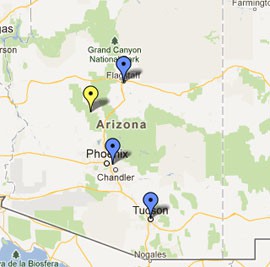Cronkite News has moved to a new home at cronkitenews.azpbs.org. Use this site to search archives from 2011 to May 2015. You can search the new site for current stories.
Half of Arizona grads carry nearly $20,000 in debt; still among nation’s lowest
WASHINGTON – Arizona college students graduated with some of the smallest levels of student debt in the country last year, according to a national report released Thursday.
The study by the Institute for College Access and Success said 49 percent of graduates getting a bachelor’s degree in Arizona in 2011 were in debt, and they owed an average of $19,950. That put Arizona 45th in the country in terms of student indebtedness.
By comparison, two-thirds of bachelor’s degree recipients nationwide had debt last year that averaged $24,854, according to the report, “Student Debt and the Class of 2011.”
The report said states in the South and West tended to have the lowest debt, while states in the Northeast and Midwest were higher.
Report author Matthew Reed said there are many factors at work, like “tuition costs, room and board, books and supplies, scholarships, family resources and low income.”
He could not point to a specific reason for Arizona’s rank, but said it is likely due to the availability of scholarships in the state.
“Arizona students in public college do receive considerable grants and scholarship aid from universities,” said Reed, who is the institute’s program director.
An Arizona Board of Regents spokeswoman agreed, saying that financial aid provided by public universities is a contributing factor to the state’s lower-than-average student debt.
Katie Paquet said regents policy requires that the state’s three public universities “set aside 14 percent of tuition revenues for need-based financial aid.”
“In recent years, the Board has asked the universities to set-aside at least 17 percent. In reality, the universities provide much more,” she said in an email.
In 2010-11, the public universities provided $391 million in institutional scholarships and grants to 69,069 students, Paquet said. Over the last five years, awards of institutional aid have also increased by $167 million at the three public campuses: University of Arizona, Arizona State University and Northern Arizona University.
Paquet said another factor is the state’s “reasonable higher education costs,” which she said “undoubtedly contribute to the low level of student debt.”
“Despite increases in recent years, tuition and fees at Arizona’s public universities remain competitive among similar institutions,” she said.
Prescott College, a private, non-profit liberal arts school in Arizona, saw 64 percent of its 2011 graduates leave in debt, but at a considerably lower average of $13,737, according to the report.
Prescott’s financial aid director was not surprised by the numbers.
“Our students tend to borrow money, by federal loans, to meet costs,” Mary Frances Causey said.
With a “pretty generous” scholarship program, Causey said about 90 percent of the college’s students receive some kind of partial institutional tuition funding for their undergrad studies.
But she said state grants for private schools have fallen from $40,000 to $50,000 before 2010, to less than $10,000 this year.
“As a private college we don’t have a lot of resources,” she said.
Reed said the report aims to flag the issue of student debt to policymakers and the public, and show the need for financial assistance reform. That is particularly true for aid directed to those in the greatest financial need, based on family income and assets, he said.
“There need to be policy choices at a state and federal level that affect borrowing,” Reed said. “Federal, state and college policymakers should focus on providing need-based financial aid to reduce the need to borrow.”







